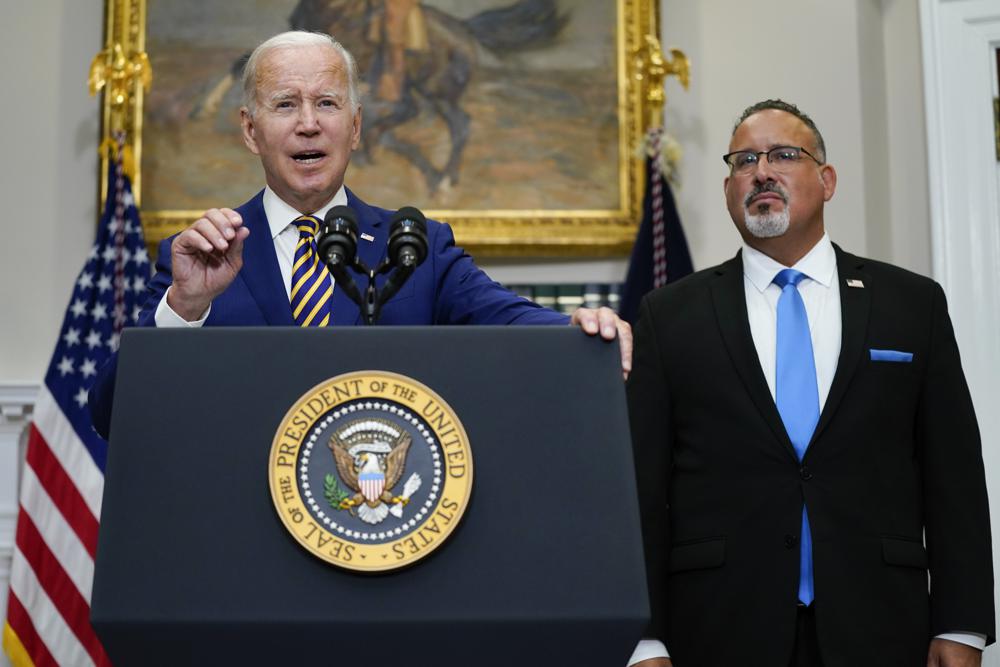National
EXPLAINER: Where does student loan forgiveness stand?

A federal appeals court in St. Louis has created another roadblock for President Joe Biden’s plan to provide millions of borrowers with up to $20,000 apiece in federal student-loan forgiveness.
The court on Monday agreed to a preliminary injunction halting the program in one of several cases challenging the debt relief plan.
With the forgiveness program on hold, millions of borrowers have begun to wonder if they’ll get debt relief at all. The fate of the plan will likely eventually end up in the Supreme Court.
Here’s where things stand:
HOW THE FORGIVENESS PLAN WORKS
The debt forgiveness plan announced in August would cancel $10,000 in student loan debt for those making less than $125,000 or households with less than $250,000 in income. Pell Grant recipients, who typically demonstrate more financial need, would get an additional $10,000 in debt forgiven.
College students qualify if their loans were disbursed before July 1. The plan makes 43 million borrowers eligible for some debt forgiveness, with 20 million who could get their debt erased entirely, according to the administration.
The Congressional Budget Office has said the program will cost about $400 billion over the next three decades.
The White House said 26 million people have applied for debt relief, and 16 million people had already had their relief approved.
A HOLD ON THE PLAN GETS EXTENDED
The ruling Monday was made by a three-judge panel from the 8th U.S. Circuit Court of Appeals in St. Louis, which has been considering an effort by the Republican-led states of Nebraska, Iowa, Kansas, Missouri, Arkansas and South Carolina to block the loan forgiveness program.
The ruling from the panel made up of three Republican appointees — one was appointed by President George W. Bush and two by President Donald Trump — extends a hold until the issue is resolved in court. Previously, the court had put it temporarily on hold.
Nebraska Attorney General Doug Peterson, a Republican, said in a statement that the ruling “recognizes that this attempt to forgive over $400 billion in student loans threatens serious harm to the economy that cannot be undone.”
White House Press Secretary Karine Jean-Pierre said the administration is confident in its legal authority for the student debt relief plan.
“The Administration will continue to fight these baseless lawsuits by Republican officials and special interests and will never stop fighting to support working and middle class Americans,” Jean-Pierre said.
A TEXAS JUDGE FOUND BIDEN OVERSTEPPED
On Thursday, U.S. District Judge Mark Pittman — an appointee of former President Donald Trump based in Fort Worth, Texas — ruled that the program usurped Congress’ power to make laws. The administration immediately filed a notice to appeal.
Pittman said the Higher Education Relief Opportunities for Students Act of 2003, commonly known as the HEROES Act, did not provide the authorization for the loan forgiveness program.
The law allows the secretary of education to waive or modify terms of federal student loans in times of war or national emergency. The administration said the COVID-19 pandemic created a national emergency.
But Pittman said such a massive program required clear congressional authorization.
The plan has faced other legal challenges. In October, Supreme Court Justice Amy Coney Barrett rejected an appeal from a Wisconsin taxpayers group. A federal judge had earlier dismissed the group’s lawsuit, finding they didn’t have the legal right, or standing, to bring the case.
THE TEXAS RULING WAS A BLOW TO THE PLAN
Pittman’s decision strikes down the underlying legal argument used to justify Biden’s plan. Previously, the White House has been able to dodge legal attacks made in lawsuits by tweaking details of the program.
One lawsuit argued that the automatic debt cancellation would leave borrowers paying heavier taxes in states that impose a tax on canceled debt. The administration responded by allowing borrowers to opt out. Another suit alleged that Biden’s plan would hurt financial institutions that earn revenue on certain kinds of federal student loans. The White House responded by carving those loans out of the plan.
The Texas ruling, however, argues that the HEROES Act does not grant authority for mass debt cancellation. The law grants the Education Department wide flexibility during national emergencies, but the judge ruled that it’s unclear whether debt cancellation was a necessary response to COVID-19, noting that Biden recently declared the pandemic over.
IS THE CASE BOUND FOR THE SUPREME COURT?
The legal situation is complicated because of the numerous lawsuits. It’s likely that the Texas case and the lawsuit filed by the six states will be appealed to the Supreme Court. Before it reaches that level, the 5th and 8th Circuit appeals courts — both dominated by conservative judges — will rule separately in each case.
The case before the 8th Circuit could end up in the Supreme Court soon now that the panel has granted the injunction sought by the six GOP-led states.
Likewise, the administration has signaled it will appeal the Texas ruling. If the 5th U.S. Circuit Court of Appeals is asked to block Pittman’s ruling pending appeal, the losing side could then turn to the Supreme Court.
In either case, appellate courts would not issue a final ruling on the validity of the program, but on whether it can go forward while challenges proceed.
Meantime, the Biden administration is no longer accepting applications for student loan forgiveness.


Kent Porter
November 15, 2022 at 8:56 am
These spoiled BRATS signed loan papers , TIME TO PAY UP !!!!!!!!!!